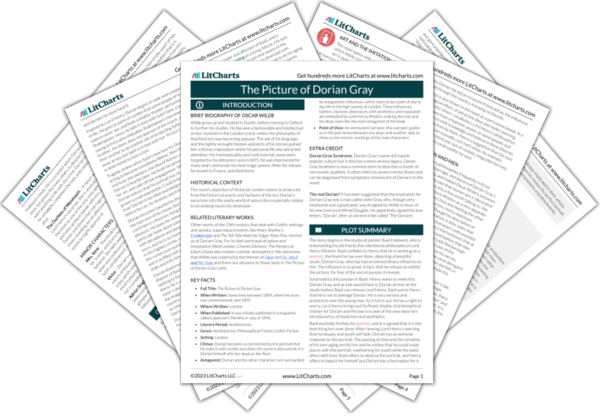Summary
Analysis
In the morning, Dorian is sleeping like a baby when the servant comes in to wake him. He wakes pleasantly, smiling as if from a lovely dream. But soon, the night’s bloody events come back to him. Dorian sickens and feels again the loathing for Basil that had caused him to strike. How strange it is, he considers, to have a corpse laying up there in the daytime. He feels that the memory must be driven out to stop him from going totally mad.
It is interesting that in the forgetfulness and innocence of sleep, Dorian’s face takes on a childlike appearance – we realize how old and tortured his internal life has become. A symbol of clarity and freshness, the daytime, has become sour and dark with the morbid secret, showing how all appearances are deceiving now.
Themes
Literary Devices
Quiz
Test Yourself
Dorian dresses carefully, and breakfasts, taking time over everything. He reads his mail, one letter seemingly from one of his wronged women. He writes a letter to Alan Campbell and sends it away with his servant. He spends some time sketching, but soon the drawings start to resemble Basil Hallward. Determined to distract himself, Dorian goes to the bookshelf and picks an ornately bound volume of poetry. He reads one about Venice, and it transports him to the canals perfectly. He remembers with pleasure the romance of the city, but then it occurs to him that Basil had been his travelling partner.
Dorian has a routine of practical affairs to take care of, but he turns to art to soothe his tormented thoughts. Nothing else will distract him. He even starts drawing, taking but just as Basil once feared that he was too visible in his portrait of Dorian, now Basil is too visible in Dorian's sketches. The soothing words of poetry surround Dorian with a brief reverie but reality interrupts. This art can’t compete when Dorian’s own life is the ultimate piece of work.
Themes
Quiz
Test Yourself
Eventually, after much nervous waiting by Dorian, Alan Campbell arrives. Alan was a science scholar and a musician, and he and Dorian had spent over a year in close company, but now Alan, like many others, avoids Dorian. Alan has a pale, dejected appearance. He tells Dorian that he never wanted to come to this address again, but that he’d been told it was an emergency. Dorian tells Alan about the body, claiming it was a suicide, and asks him to take it away, to treat it as just another of his experiments. Alan refuses, calling it “devil’s work”. Dorian then tells him the truth. He begs Alan to pity him and remember the intimacy they used to share. But Alan is unmoved, even when Dorian says he will be hanged for the crime.
The lack of pity that Alan has for Dorian, and indeed the actual fear that Dorian’s presence causes him, is evidence of Dorian’s mysterious lost years that in chapter 11 were spoken of as years of decadence and sin. The sickness that has plagued Dorian’s mind is now literally visible in Alan, showing that Dorian’s devilish influence has spread and taken hold of others. Just as Lord Henry influenced Dorian, Dorian has influenced others. But Alan refuses to be influenced any longer.
Themes
Quiz
Test Yourself
Dorian then writes something on a piece of paper and shows it to Alan. Alan falls back on his chair. His whole demeanor changes. Dorian shows him a letter he has already written which would realize the threatened action. Alan can’t refuse now. Dorian reminds Alan that he has used him badly in the past and now it is time for Dorian to be in control. Pained and sickened, Alan begins to think of the practicalities of getting rid of the body. He sends Dorian’s servant away for the necessary equipment from his lab.
So Dorian forces Alan to help him. He uses Alan completely. He sees in his old friend only a set of skills that can help him escape his guilt. It is as if Dorian has usurped the spirits of those around him in order to stay strong and young himself. There is a sense that as the painting warps and ages, so too do Dorian’s friends become visibly destroyed under his influence.
Themes
Quiz
Test Yourself
Get the entire The Picture of Dorian Gray LitChart as a printable PDF.

Dorian has tears in his eyes and tells Alan that he has saved his life, but Alan feels no pity, only anger. The servant soon arrives with the materials and Dorian and Alan the two climb the stairs to the schoolroom. At the door, Dorian loses courage. Alan tells him he can manage alone. But as the door is opened, Dorian catches a glimpse of the portrait, and its gory colors seem even worse to him than those of Basil’s body. Dorian goes in and covers the painting, and leaves Alan Campbell to his work. Over five hours later Alan emerges, his task completed. As he leaves, he says he hopes to never see Dorian again.
Dorian is less affected by what he has done to others—the gore, Basil’s still body, the suffering of Alan—than the evidence of what he has done to himself that is visible in the painting. It is not something he can bear anyone else to see, even if Alan would be unsurprised given his experiences with Dorian.
Themes
Quiz
Test Yourself












